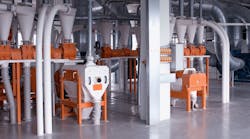How To Balance Energy Efficiency and System Capability in Pneumatic Conveying Systems
For food processing companies, pneumatic conveying systems are a major source of energy consumption. This makes the system an area of focus for energy efficiency.
As such, it is common for companies to specify or retrofit a system with a blower that uses the smallest possible size motor. Unfortunately, this overlooks an issue of equal if not greater importance: system capability.
While a blower with a motor that meets the minimum power requirements can deliver good performance under normal operating conditions, not every day will see normal conditions—pipes get clogged and other unforeseen issues can arise that reveal the motor to be underpowered.
It’s critical that food processing companies balance their goal of energy efficiency with maintaining full system capability. To do this requires understanding the system needs in both normal and non-normal operating conditions, then calculating the exact power requirements based on the system design and function.
The Importance Of System Capability
Among food processors, one of the most common challenges is pipe clogging. When a pipe is jammed, as the motor runs it increases the pressure in the pipe. A motor that has only the minimum amount of power may not be able to produce enough pressure to unjam the clog before either overheating and/or triggering a shutdown. This can result in two serious and costly outcomes.
The first is that the pipe must be disassembled and cleaned manually. The second is that the blower and/or its motor can become damaged. Even if the motor is still functioning after a cooldown, repeated instances of this can shorten the lifespan of the motor.
In contrast, a blower with a slightly more powerful motor may be able to continue applying pressure to such a clog until it is finally pushed through. This is just one example of sizing for system capability.
Cost is another important factor. Labor costs in food processing far exceed energy consumption costs. Thus, an underpowered system is not going to save any money.
System Factors To Consider
On average, the right blower should have a motor with about 20% to 30% more power capacity than the minimum needed for the system under normal conditions. This extra power can help avoid downtime and excess labor costs from motor failures, clogs, and other issues that can arise from an underpowered system. Calculating the right motor size for a pneumatic conveying system is challenging, however, and means weighing a variety of factors, including:
Length of the Pipe
Pipe length is one of the most significant factors. Longer pipes require greater pressure to move materials.
Ratio of Horizontal to Vertical Lengths
Vertical pipe sections require pushing both air and material against gravity, which again increases the pressure needs of the system.
Number of Bends
Each time a pipe bends it creates new friction against the pipe wall, which adds to the power needs. Clogs such as those mentioned above are most likely to occur at a bend.
Pipe Material
Different types of pipe materials (e.g., stainless steel, aluminum, PVC, etc.) have different coefficients of friction. This friction, combined with the length has a significant impact on the pressure needs.
Conveying Method (Dilute Phase vs. Dense Phase)
Material moved in the dilute phase is generally limited to about 15 psig, whereas the dense phase has an average maximum pressure of 50 psig.
Product Friction Coefficient
Similar to pipe material, rougher food material (e.g, coffee beans) will have more friction than smoother material (e.g., baby formula), which in turn requires more power.
Air Density at Suction Site
Believe it or not, even the geographic elevation of the factory can impact the power of the motor needed in a pneumatic conveying system. Higher elevations have lower air density than lower elevations, which can require more power to move the same amount of material.
The Right Partner Can Help Choose The Right Blower Technology
With all of the factors to consider in selecting the proper blower with the right motor size, food processing companies may need the help of a reliable supplier partner. After all, food processing is their expertise, not air friction calculations. When choosing a partner, companies should consider:
Level of Expertise
Does the partner have a long history of producing products for pneumatic conveying systems?
Depth of Product Portfolio
Does the partner have a sufficient range of products to meet current and future needs?
Application Expertise
Does the partner have experience working within key industries in the food processing market handling a wide variety of materials?
Service Capabilities
Does the partner have service centers located reasonably close to the facility?
Customized Product Solutions
Is the partner capable of producing wholly unique blower bundles when the situation calls for it?
Training Options
Can the partner train in-house staff so that they can better understand the interaction between the blower technology and the system operation, including common pneumatic conveying setbacks or preventative maintenance?
While energy efficiency will always be important in any system, it should never come at the expense of system capability. To ensure a blower has the right motor size for a given pneumatic conveying system, food processing companies should keep these three things at top of mind:
- the material conditions on the pneumatic conveying
- the material speed, which is determined by the blower speed
- the amount of pressure needed in the system, as more pressure leads to more handling capacity within a given pipe diameter.



